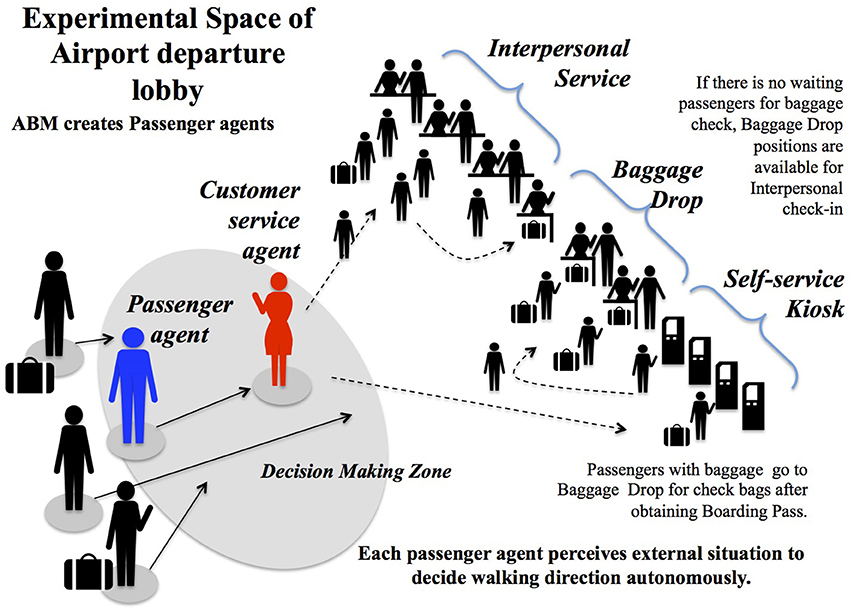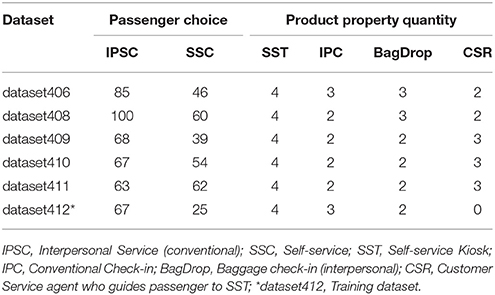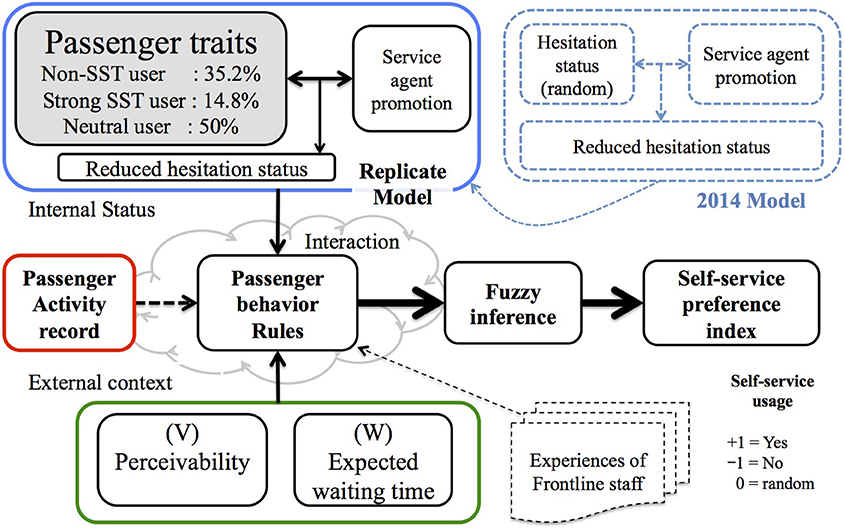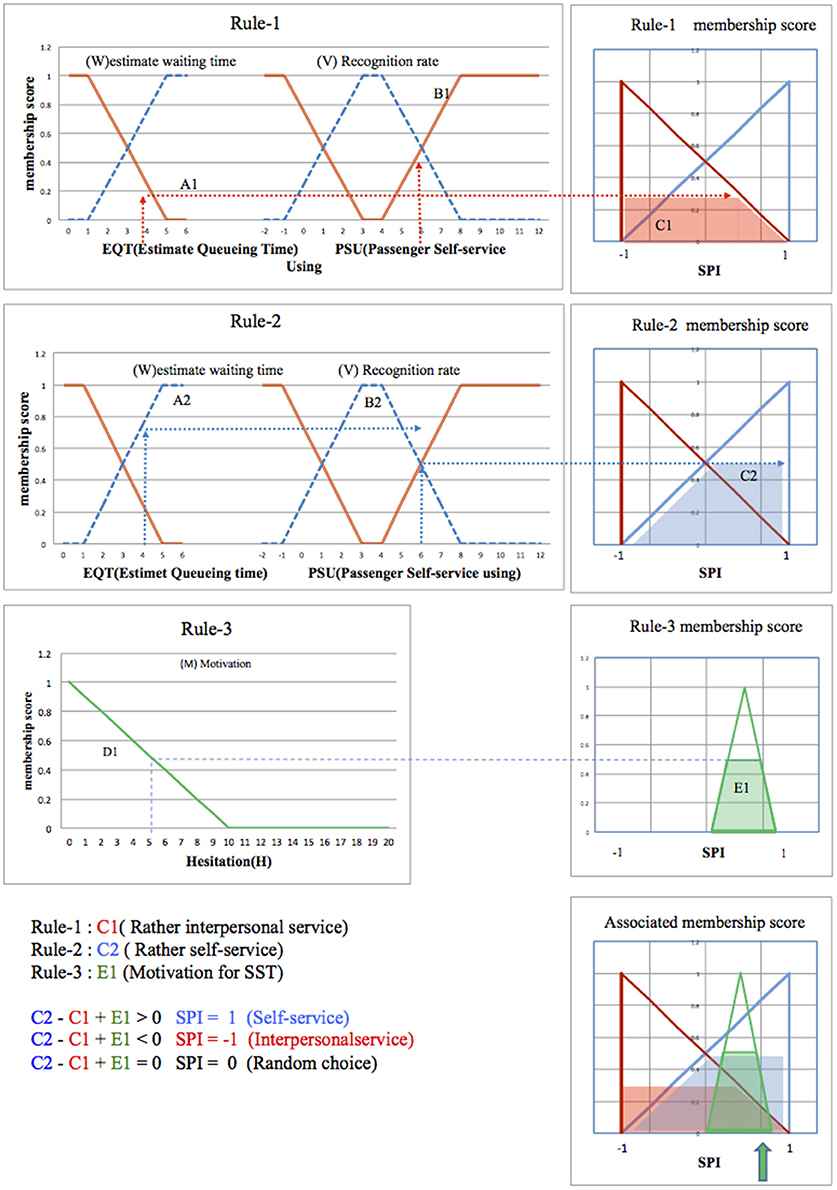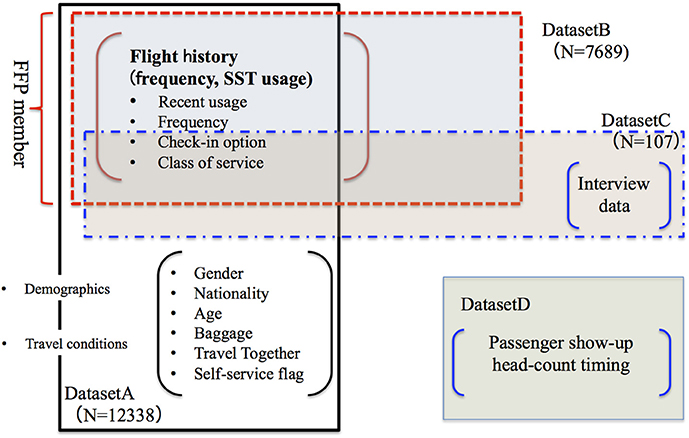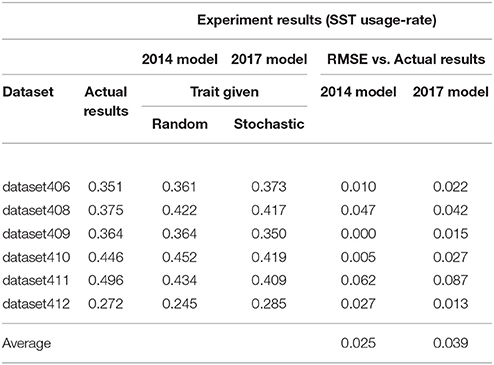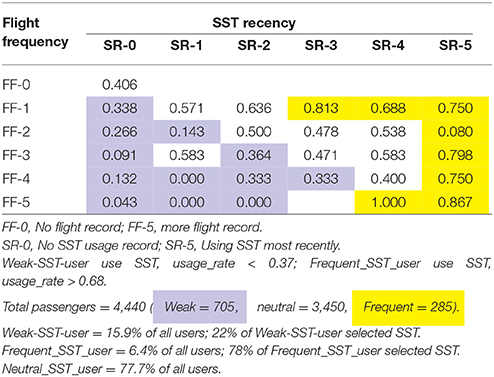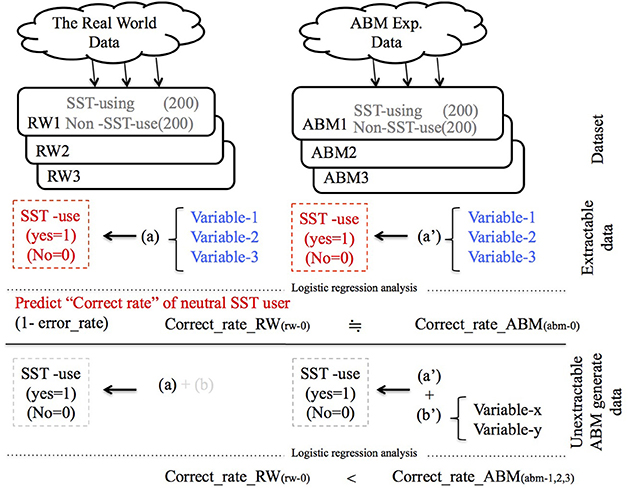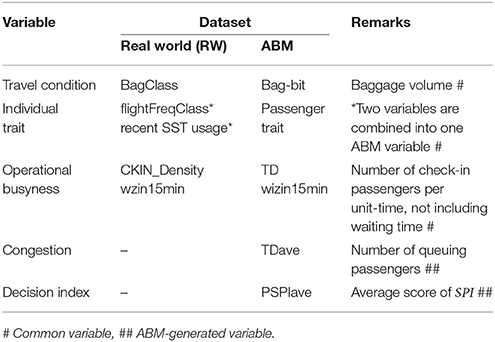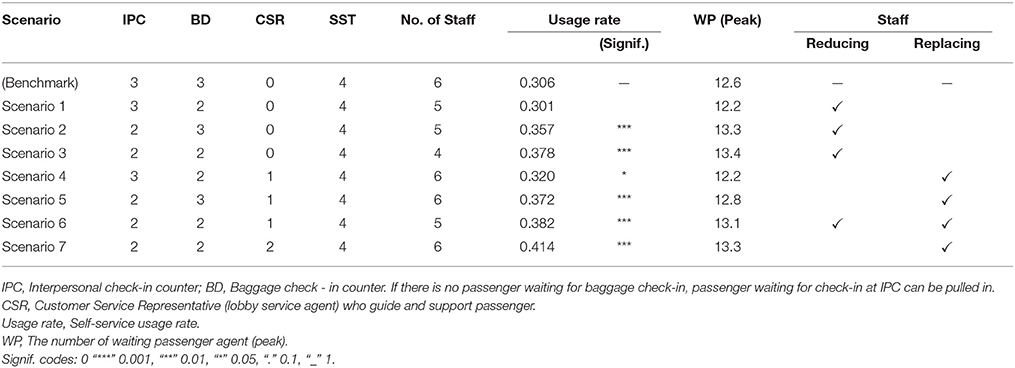Agent-Based Self-Service Technology Adoption Model for Air-Travelers: Exploring Best Operational Practices
- Graduate School of Systems Management, University of Tsukuba, Tokyo, Japan
The continuous development of the service economy and an aging society with fewer children is expected to lead to a shortage of workers in the near future. In addition, the growth of the service economy would require service providers to meet various service requirements. In this regard, self-service technology (SST) is a promising alternative to securing labor in both developed and emerging countries. SST is expected to coordinate the controllable productive properties in order to optimize resources and minimize consumer stress. As services are characterized by simultaneity and inseparability, a smoother operation in cooperation with the consumer is required to provide a certain level of service. This study focuses on passenger handling in an airport departure lobby with the objective of optimizing multiple service resources comprising interpersonal service staff and self-service kiosks. Our aim is to elucidate the passenger decision-making mechanism of choosing either interpersonal service or self-service as the check-in option, and to apply it to analyze several scenarios to determine the best practice. The experimental space is studied and an agent-based model is proposed to analyze the operational efficiency via a simulation. We expand on a previous SST adoption model, which is enhanced by introducing the concept of individual traits. We focus on the decision-making of individuals who are neutral toward the service option, by tracking the actual activity of passengers and mapping their behavior into the model. A new method of validation that follows a different approach is proposed to ensure that this model approximates real-world situations. A scenario analysis is then carried out with the aim of exploring the best operational practice to minimize the stress experienced by the air travelers and to meet the business needs of the airline managers at the airport. We collected actual data from the Departure Control System of an airline to map the real-world data to the proposed model. Passenger behavior was extracted by front-line service experts and clarified through consecutive on-site observations.
1. Introduction
1.1. Background
The service economy continues to grow globally. Both developed and emerging countries are expected to face difficulties in securing workers in the future. Developed countries need to address this progressive and imminent issue in their aging societies. In these countries, the working population enjoys improved health care and has fewer children; thus, industries are required to secure their workforces in new ways. Clearly, we need some mechanism to offer enhanced service and improved interactions with consumers. Self-service technology (SST) is a promising alternative for fulfilling future customer service requirements. However, unless SST is recognized and accepted by the customers, the implementation of SST is unlikely to be successful, resulting in neither customers nor firms enjoying the benefits of service investment.
This study focuses on self-service kiosks at the airport, as these are a familiar alternative for air travelers. In general, service is characterized by simultaneity and inseparability, which, in our situation, means that service agents and passengers need to work together to achieve a common goal in each of the processes that form the constituents of air travel. In particular, because the check-in process is a critical starting point for improving the travel experience, smoother operation in cooperation with the passenger is required to provide a certain level of service. It is essential for both airlines and passengers to utilize the SST at the airport because it reduces stress and the amount of waiting time. Time and suitable opportunities are required to identify the best practice for fully utilizing the resources including SST. Conducting a trial is a common strategy to evaluate the functioning of a new policy, the performance of which is also challenging to verify under new circumstances. However, it is difficult for on-site managers to understand the statistical result and analysis and apply its findings to a service operation in practice. Further, because the operational trial involves a certain degree of risk in that it may adversely affect the service quality, local managers would prefer to prevent sacrificing the customer's experience as much as possible rather than conducting operational trials in the field. An experimental space helps managers to understand the circumstances of a new handling policy without conducting actual try-and-error trials, if it stably reproduces real-world phenomena.
1.2. Purpose of this Study
This study investigates the way in which coordination and cooperation take place in the airport departure lobby. The optimization of current resources is key in achieving the same goal for both passengers and the airline. We investigate how effectively both SST and service staff engaging in interpersonal service can achieve a harmonized performance.
To achieve this, two steps are undertaken to uncover the fundamentals of smoother passenger handling operation: constructing the experimental space and scenario analysis by simulations. The first of these two steps of this study consists of proposing an experimental space to which to map the real-world situation. In this regard, we utilize agent-based modeling (ABM) to emulate the departure lobby of an airport with existing data collected from an airline system. We focus on the decision-making process of a passenger who is neutral toward SST use. Because it is important to know what causes an individual to opt for SST when they have not yet determined an attitude toward it, we develop an SST adoption model by introducing an aggregate analysis of passenger records from an airline system. We also propose a methodology to validate the proposed ABM in order to clarify that the core mechanism is robust and that the designed concept functions as intended. Then, we carefully construct several scenarios to determine the best combination of SST and service staff to ensure a certain level of quality.
This research is based on computer simulation experiments. This study was carried out in accordance with the guideline of “Researcher's ethics” of the University of Tsukuba. This study complies with Regulation for Faculty of Business Science Research Ethics Committee. An ethics approval was not required as per institutional and national guidelines and regulations.
2. Related Work and Findings
SST has been examined from various perspectives. First, as SST adoption is an individual decision to adopt a new method, we review studies pertaining to the adoption and diffusion of innovation. Subsequently, an overview of the field of services marketing is given to provide the necessary background against which to understand the development of SST studies. Then we review ABM as a tool to elucidate the dynamics of the phenomenon of SST adoption. We specifically consider the ABM SST adoption model for reviewing the progress of current findings and research problems.
2.1. Innovation Diffusion
Rogers [1] defined innovation as the introduction of something new: a new idea, method, or device. The OECD Oslo Manual defines four types of innovation: product innovation, process innovation, marketing innovation and organizational innovation1. However, innovation is often also viewed as the application of improved solutions to meet new requirements, unarticulated needs, or existing market needs. This is accomplished by using more effective products, processes, services, technologies, or business models that are readily available in markets, governments, and society. The existence of designated variables to define the speed of diffusion is well-known. Greater relative advantage, higher compatibility, less complexity, higher trialability, and greater observability are known to accelerate the diffusion of innovation. The change agent has also been claimed to promote innovation and to play an important role in increasing the speed of diffusion [1]. The variables responsible for enhancing the diffusion speed indicate what we should be looking at in this study because SST adoption is an individual decision to accept innovation.
2.2. Service-Marketing Framework
The study of SST can be traced back to the study of convenience. Berry et al. [2] examined and discussed convenience from two main perspectives: (1) wait time and its management and (2) what consumers find convenient. Davis [3] developed a “technology acceptance model (TAM),” which is specifically meant to explain computer usage behavior. The developed methodology emphasizes the necessity of evaluating proposed new systems prior to their implementation. The author concluded that perceived usefulness and ease of use create favorable attitudes toward SST. Davis [4] empirically examined the ability of TAM to predict and explain user acceptance and rejection of computer-based technology.
Bitner et al. [5] explored the changing nature of service, with an emphasis on ways in which encounters can be improved through the effective use of technology. They focused on the benefits of thoughtfully managed and effectively implemented technology applications [5]. In the same year, self-service technologies were described as technological interfaces that enable customers to produce a service without a service employee's involvement [6]. The use of SSTs can drive up productivity and efficiency [7–9], and additionally, reduce and avoid high labor cost.
Through various means including surveys, interviews, and questionnaires, a large number of studies have found factors that influence the usage of SST. Meuter et al. [6] concluded that service convenience through SST resulted in consumer satisfaction when it was “better than the alternatives” and they appreciated “time saving” the most. It was also claimed that SST usage depends on customer readiness for SST [10].
Liljander et al. [8] reviewed SST adoption from the perspective of consumer readiness. Meuter et al. [9] explored usage patterns and the benefits of using SSTs and their findings indicate that “technology anxiety” is a superior, more consistent predictor of SST usage than demographic variables.
Dabholkar and Bagozzi [11] extended the attitudinal model of technology-based self-service (TBSS) and proposed that the moderating variables affect the attitude toward SST and intention to use SST. Their extended framework of TBSS was well supported and captured a variety of consumer traits and situational factors.
2.3. ABM
Agent-based models, also known as multi-agent systems and agent-based simulation etc., are (computational) models of a heterogeneous population of agents and their interactions (CoMSES)2.
Technical instruments enable each agent to behave autonomously. By locating players in the experimental space and approximating it to the real world, ABM is developed and its effectiveness enhanced. A social multi-agent system represents phenomena of complex social systems [12]. Kawai [13, 14] utilized ABM and demonstrated the diffusion of new products and services using an ABM abstract model. These studies illustrate important facts and concepts for the diffusion of innovation. However, they merely illustrated the concept, and neglected to describe the reproducible mechanism of decision-making for choosing several options.
Stylized facts are empirical regularities in search of theoretical, causal explanations, such as statistical features. In the financial markets, there are a few stylized facts, such as volatility clustering and the power law decay of the tails of the return distribution [15]. As Watts and Gilbert introduced ABM literature by mentioning stylized facts, it is common to evaluate the simulation results of various fields using stylized facts [16]. Grimm et al. [17] propose a general framework for designing, testing, and analyzing bottom-up models, which is pattern-oriented modeling. The framework attempts to enhance the rigor and comprehensiveness of bottom-up modeling by explaining observed patterns. It is claimed that patterns are the defining characteristics of a system and indicators of the essential underlying processes and structures.
2.4. SST Study by Utilizing ABM
In this section, we briefly review the SST adoption model that equips ABM step by step. The building stages of the proposed ABM are reviewed to illustrate the feature of passenger handling at the airport and the basic idea of the decision-making mechanism for using SST.
2.4.1. Concept of SST Adoption Model
Ueda and Kurahashi [18] created an ABM to demonstrate how air travelers choose SST at the airport. The experimental space emulates an existing airport departure lobby (Figure 1) and has three check-in options: interpersonal check-in service, baggage drop, and self-service kiosk.
The default check-in option is the interpersonal check-in service. Travelers who use the self-service kiosk can check in their baggage at the baggage drop position. The baggage drop positions are also utilized as check-in positions when there is no-one waiting in front of them.
ABM creates passenger agents at the same volume and the same arrival timing, with certain properties according to the system log collected from the airline. The ratios of passenger demographics and travel conditions such as checked baggage are also copied into the model. It gives each passenger agent the variable value, which represents “hesitation status” toward using SST. The passenger agent reduces the “hesitation value” when the service agent interacts, as it is common and observed that passengers are encouraged to use SST by knowing that the self-service kiosk exists and functions and that it may enable them to reduce their waiting time. According to the various records (system log, on-site observation, etc.), the number of active check-in counters, self-service kiosks, and lobby service agents are also implemented as they were in practice (Table 1).
Figure 4 shows the volume and variables of the data collected mainly from the airline system.
2.4.2. Decision-Making Mechanism for SST Use
Figure 2 illustrates the core mechanism of the proposed model. The passenger agent is created randomly or stochastically with certain traits. Each agent moves toward check-in options in the lobby and decides its direction autonomously by collecting surrounding information.
The perceived waiting time and visibility of SST are key inputs for fuzzy inference methodology to determine the direction of each agent. Based on the knowledge of service experts, the “Self-service Preference Index (SPI)” is calculated by following the simple fuzzy rule and membership function (Figure 3).
• Rule 1: IF W [Waiting time for conventional check-in] is short and V[Visibility of SST] is low, THEN SPI is negative.
• Rule 2: IF W is long and V is high, THEN SPI is positive.
• Rule 3: The more the lobby service agent interacts with passengers, the higher the possibility of using SST.
If SPI is positive, the agent moves toward SST. If SPI is negative, the agent moves toward the conventional check-in counter. Sixteen days of on-site observation clarified that passengers' actual behavior followed the defined rule almost consistently.
Figure 3 illustrates that the fuzzy system calculates the SPI score by using the max-mini inference method and the simplified centroid method.
The Equation (1) defines the calculation of EQT, which is the input value to find the membership score of variable W. A passenger agent moving toward the interpersonal check-in service is taken as the default option. However, in the decision-making zone, it estimates and compares the waiting time of the two check-in options.
EQT is defined as the predicted difference in waiting time at the interpersonal check-in, and the wait time for using SST. It has weighting parameters for check-in preference (“p1” and “p2”), If p1 and p2 have the same value, the preference for the two options are the same; however, few passengers prefer SST. The variable V reflects how the passenger perceives SST. The number of passenger agents in front of SSTs is the input value of V. When there is no agent using SST, V is low; when there are more agents using SST, the value V becomes higher. If the number of passengers who are in front of SSTs exceeds the number of SSTs, V decreases, because passengers would occupy the self-service area and then the visibility of the SST significantly decreases. This model places the customer-service staff in the experimental space because the front-line staff's experience and the findings of previous work indicate that passengers respond positively to use SST under the guidance of the airport staff [7, 19]. Similar to the different preferences of an actual individual, each created agent is assigned a different attitude toward using the SST. ABM assigns each passenger agent a random “hesitation” value from 0 to 20. If the “hesitation” value is high, the chances of using the SST are less. If the passenger agent reduces their “hesitation” value by contacting the customer service agent, there is a greater chance of using the SST.
2.4.3. Model Development
The replicated SST adoption model [22] introduces the concept of an attitudinal model of [11], which claims that the attitude and intention of using the SST directly influences several moderating variables such as consumer traits and situational factors.
An aggregate analysis of the airline records (DatasetB: Figure 4) supports the idea that situational factors and passenger traits influence the attitudes of individuals toward SST. The regression analysis demonstrates the significance of explanatory variables representing travel conditions such as the volume of held baggage and busyness of passenger handling.
The variable “recent use of self-service kiosk” indicates the service that is chosen the most, whereas the other variable “flight frequency of passenger” occupies the second position. These findings are reflected by modifying the SST adoption model to assign each produced passenger agent an individual trait: Non-SST user 35%, Strong SST user 14.8%. The ABM assigns each agent a random non-negative number up to 100. Depending on the score the agent holds, the trait category of passenger agent is defined stochastically.
2.4.4. Simulation Result
Verification and validation processes are carried out carefully using six datasets: one dataset (dataset412) is used for training and the remaining datasets are used for validation.
Various parameters, including the baggage holder rate (0.7), and the processing times for the different service options (interpersonal service, self-service, and baggage check-in), are set to represent real-world conditions. After fitting the two parameters (p1 and Speedmax: maximum moving speed of passenger agent) by calibration, we conducted experiments using the other datasets with different circumstances. In each experiment, the number of check-in counters and staff is mapped according to the actual situations on those days. Experiments were conducted by using 50 runs each for the five test datasets, which differ completely in terms of the timing of passenger arrival. In these experiments, the self-service usage rate, the quotient of passengers using self-service divided by all passengers, is observed.
The results of the simulation for each model are provided in Table 2. The simulation result is sufficiently close to the real-world situation and is persuasive for modeling actual passenger handling at the airport. Table 2 indicates that in the replicated 2017 model, the RMSE (Root Mean Squared Error) for the self-service usage rate versus the real data is 0.039, which is higher than that in the 2014 model. However, the core of the SST adoption model supports the concept developed by previous services marketing literature and innovation studies, namely the effect of technology readiness and anxiety, and moderating variables with fuzzy inference systems are used to demonstrate the dynamic mechanism of SST adoption. In addition, the result of experiments finds that calibration results of two parameters are different: the speed of the passenger agent (Speedmax) is linearly related to the self-service usage rate, whereas the interpersonal preference of an individual (p1) is non-linearly related to the self-service usage rate.
2.5. Topics of Related Work
Previous innovation diffusion studies typically describe the introduction of a new method and introduce the variables that determine the rate of adoption. The services marketing literature explores and specifies factors that promote the use of technology-based self-service (TBSS). Dabholkar and Bagozzi [11] expanded the concept of a technology acceptance model to explicate that situational factors and consumer traits have a direct effect on promoting a positive attitude toward TBSS and the intention to use TBSS. They conducted an on-site survey at a fast food restaurant to examine the behavior of consumers. However, as Dabholkar noted, the results would change if one of situational factors was to change. Those studies are based on statistical methods, and this means that the analysis is static rather than dynamic. Inductive approaches based on statistical models are often inadequate for elucidating “complicated consumer behavior mechanisms” and “complex phenomena occurrence mechanisms” [20].
Applying the TAM proposed by Davis [4] in user acceptance testing would involve demonstrating system prototypes to potential users and measuring their motivation to use the alternative systems. Although “consumer behavior experiments can provide theoretical insight on consumer decision making and response to marketing measures, it is practically difficult to experiment with a large number of subjects and to examine the complicated interaction among consumers [20].” Studies in the services marketing field have not determined the mechanism by which predictable results can be reliably reproduced.
Kawai proposed the diffusion of new products and services utilizing ABM [13, 14]. Although his model demonstrated the phenomenon of diffusion, the model does not use data observed in the real world. Therefore, the model succeeds in illustrating the concepts but it does not represent the actual phenomenon of diffusion or reveal consumers motivations for selecting a new alternative.
The SST adoption model [18, 22] was used to conduct simulation experiments with actual data collected from an airline and approximated the experimental space to the real world (Table 2). These models were validated by comparing the self-service usage rate of the simulation results against the actual recorded activity, under different circumstances and various patterns of passenger volume and arrival timing (Table 1). The results clarified that the statistical features of mass behavior are similar. However, it is necessary to find other stylized facts shared by the two spaces, which can render more credibility to the proposed SST adoption model.
The above-mentioned previous results suggest that a model capable of addressing the concerns of on-site managers would need to stably reproduce the situation and operations of the departure lobby. The service operations consist of coordination and cooperation of service resources and interactions among passengers, which ABM is inherently capable of representing.
3. Enhancing SST Adoption ABM
The results of experiments with the SST adoption model [18, 22] closely reproduce the real-world situation and indicate that there is room for improvement. In section 3.1, we focus on individuals who have not determined their attitude toward SST and their decision-making, by using a detailed analysis of the data from the records of the airline system. We clarify the effectiveness of this proposed agent-based model by utilizing logistic regression analysis. At the end of this section, we discuss the fact that the experimental space creates stylized facts similar to those in the real world.
3.1. Narrowing the Data Scope
The experimental results support the idea that individuals' choices depend on situations, as claimed by Dabholker. However, we reconsider the scope of the data because the results of the 2017 model, in which traits are given stochastically, are not as close to the actual recorded activity as the results of the 2014 model, which assigns random traits to passenger agents.
The examined data for the replicated SST adoption model [18] was collected during five days of operation time and covers both quiet and busy times. As the experiment tries to explicate the peak hours of the real world, we extract data from the peak hours of operation (7:00–8:15) from DatasetB (Figure 4).
We examine data from a total of 4,440 passengers and divided these data into 36 segments using two variables that explicate the usage of the self-service kiosk the most according to multiple regression analysis (Table 3) [18]. The flight frequency is divided into 6 categories; FF-0 classified passengers have no flight record during the last 24 months from the departure date. Passengers who fly more frequently are divided into higher classes. Recent SST usage is also divided in the same manner: passengers classified as SR-0 have no record of using SST within the past 2 years, and SR-5 passengers have used SST recently. Table 3 lists the SST usage rate in each passenger segment. We classified passengers into three categories: Weak-SST-user, Neutral-SST-user, and Frequent-SST-user by investigating the SST usage rate of each segment. In this particular dataset, 15.9% were Weak-SST-users and 6.4% were Frequent-SST-users with SST usage rates of 22 and 78%, respectively.
3.2. Mapping the Stepwise Decision-Making of Service Selection
The replicated adoption model based on ABM is modified such that each agent is generated with a categorized trait toward SST according to the result shown in section 3.1. This takes into consideration that actual passengers with certain traits decide whether to use SST after arriving in the departure lobby. This sequence of step-wise decision-making is introduced into the proposed ABM. Further, a Weak-SST-user is stochastically allocated a 12.5% intention of using interpersonal service, because 78% of Weak-SST-users select not to use SST in this particular dataset. In the same way, a Frequent-SST-user is assigned a stochastic SST-using intention of 5%, because 78% of them ultimately used SST. The remaining agents move in the experimental space without antecedent conditions. They perceive the situation and make decisions according to the behavior rules. We would like to discern the behavior of those passengers who have not made up their mind. In the next section, we focus on validating how those who have a neutral trait toward SST make their decisions.
3.3. Validating ABM from a Different Perspective
It has long been known that a single pattern observed at a specific scale and hierarchical level in a complex system is not sufficient for reducing the uncertainty in the model structure and parameters [17]. In this section, we illustrate that a phenomenon not incorporated in the model has emerged from ABM. Its occurring pattern is statistically similar to the pattern in the real world, which is another stylized fact of the proposed model. The outline of the experiment is illustrated in section 3.3.1. The results of the experiment are shown in section 3.3.2, in order to discuss what they indicate. We summarize the experiments and discussion to evaluate the proposed model in section 3.3.3.
3.3.1. Outline of ABM Validation
According to the experimental result in section 2.4.4, we can assume that the proposed model closely approximates the real-world situation because the SST usage rate of various simulation results is approximately equal to the actual recorded activity. In section 3.2, deeper insight into passenger traits and decision-making processes enhances the model. We validate the core of the decision-making mechanism by examining the simulation results of the enhanced model.
Thirty simulation runs with one of the datasets are conducted to accumulate the activity record; 2,700 passenger agents are generated for the experimental space. Dataset412 is chosen because on that day, we observed that lobby service staff had not interacted or guided passengers much and little positive feedback was received from passengers. Equivalent amounts of records representing (1) the actual passengers and (2) the generated passenger agents are randomly selected from both the real world and ABM experiments to form six datasets. These datasets are analyzed by logistic regression, and we examine the ability of the model to accurately predict the usage or non-usage of SST (that is the objective variable). We focus on the passengers and agents with neutral traits because we aim to identify the decision-making mechanism of those who have not determined their choice.
We compare and discuss the accuracy of the predictions for the two groups by using the same explanatory variables (Figure 5).
3.3.2. Experimental Results and Discussion
The ABM experimental space emulates the real, existing world; however, it is difficult to cover all the necessary data to represent complex real-world scenarios. The airline stores its vast volume of activity records in their data warehouse. However, it does not cover all passenger activities. The question as to what types of information we need in order to represent the real world always remains. We select three explanatory variables (travel condition, individual traits, and operational busyness) to conduct the logistic regression analysis for predicting SST use. These variables were selected to help explain the objective variable: SST use or not (Table 4).
A total of 1,200 datasets are selected randomly to form three datasets containing the real world data. Each dataset contains an equal number of two different passenger groups: those using and those not using SST. The results of the logistic regression analysis of each experiment are listed in Table 5.
It displays the correct rate of SST usage prediction (Equation 2) of neutral trait groups for each experiment. We can see that the experimental results of real-world data (0.549) are close to those of the ABM data (0.537). This result, a slight gap in prediction accuracy by logistic regression, implicates that two different spaces hold data that have the same degree of difficulty explaining the complex world.
3.3.3. Summary of the Validation
We focus on passengers who have not decided whether to use the SST to validate the extent to which the proposed ABM approximates the real world and to assess the robustness of its core mechanism. Passenger traits are examined with the narrowed range of data, namely the busy peak time. The model is thereby enhanced because it provides deeper insight into passenger trait analysis as a result of stepwise decision-making, as implemented in section 3.2.
In addition to the SST usage rate, focusing on the SST usage prediction accuracy, we observe that the experimental space contains variables to explain it to the same degree as the real world. It means that the logistic regression analysis outcomes of the real world and ABM both indicate that each space has almost the same complexity to predict. Through our experiments, we observe multiple patterns in the real system at different hierarchical levels; the SST usage rate is a statistical feature of the group behavior, and the prediction accuracy is another statistical feature of individual behavior. With two dimensions of observable simplified presentation of empirical findings—in other words, the stylized facts—it can be presumed that the ABM experimental space approximates the real world.
If a model is overly complex, the analysis of its results is likely to be cumbersome and likely to be complicated by details. Conversely, an over-simplified model would neglect the essential mechanisms of the real system, thus limiting its potential to provide an understanding of and testable predictions regarding the problem it addresses. Thus, we need a method that would optimize the model complexity [17].
This study demonstrates a method suitable for extracting essential principles and minimal information from real-world situations to represent existing phenomena. It also implicates that the knowledge of front-line experts is helpful in constructing an ABM.
4. Scenario Analysis
In this section, we conduct scenario experiments using the proposed model and discuss cooperation and coordination in the passenger service operation. Section 4.1 explains the series of scenarios. The experimental results are presented in section 4.2; the results are analyzed, discussed, and evaluated in section 4.3, followed by a summary of the scenario analysis in section 4.4.
4.1. Experimental Scenarios
We conducted experiments with different scenarios based on the proposed model (2014 model) and discuss cooperation and coordination in passenger service operations. The main purpose of the scenario analysis is to examine the extent to which the coordination of service resources are effectively managed and to determine the approach the service provider could follow to cooperate with service recipients.
The scenario analysis involves examining the effect of (1) increasing and decreasing the quantity of service functions and (2) replacing the role of service staff. We discuss the simulation results in terms of the business needs of airport managers, including the cost effectiveness of current staff, increasing the number of future SST users, and moderating the impact of customer service. Table 6 displays the series of scenarios and a reference case as the benchmark.
(1) The impact of reducing the number of service staff is examined in the following cases.
• Scenario 1: Reducing 1 Baggage check-in counter (BD).
• Scenario 2: Reducing 1 Interpersonal check-in counter (IPC).
• Scenario 3: Reducing 1 BD and 1 IPC.
(2) We examine the effect of replacing the position and role of service agents in the following scenarios.
• Scenario 4: Changing 1 BD staff to lobby service agent (CSR).
• Scenario 5: Changing 1 IPC staff to CSR.
• Scenario 6: Reducing 1 IPC and 1 BD replace 1 service staff to CSR.
• Scenario 7: Reducing 1 IPC and 1 BD and change them to CSR.
4.2. Results for Experimental Scenario
Each scenario is simulated 50 times, and the average value of the following items is observed: Self-service usage rate, the total number of waiting passenger agents recorded at each step of the simulation (proxy variables of waiting time).
The simulation results of the planned scenarios and a reference case are shown Table 6. The table presents the average SST utilization of 50 experimental results for each scenario, and the average peak numbers of the total number of passenger agents waiting for check-in options.
The following result was obtained regarding the impact of reducing the number of staff. The results of scenario 1 show that a reduction in the number of IPC staff does not necessarily cause service quality to deteriorate because of an increase in waiting time. In the reference case, it can be assumed that there was a margin in the processing capacity of check-in options for the amount of work required to manage arriving passengers. Regarding the location and role changes in service staff, scenario 5 shows that the SST usage rate significantly increases when IPC staff are replaced in the lobby and used instead to guide passengers and assist them with SST operation. In scenario 4, we presume that the waiting time has decreased because the lobby service staff redeployed from IPC serves to guide passengers to utilize SST and other check-in options.
4.3. Scenario Analysis and Discussion
We comprehensively evaluated the scenario experiments by considering whether they contributed from the following three perspectives: (1) increasing the self-service usage rate, (2) reducing cost, and (3) moderating the waiting time.
Scenario 6 has a relative advantage over scenarios 4 and 5 in terms of cost efficiency and self-service usage rate. Table 6 shows that scenario 7 is the best in terms of self-service usage rate, and Scenario 6 is the second best. Similarly, the best scenario in terms of cost efficiency is scenario 3, and the second best are scenarios 1, 2, and 6, which entail a reduction in one member of the service staff. We narrow down the target of evaluation by selecting the top scenario in perspective (1) or (2) and the scenario that is ranked higher than the second-place scenario for perspectives (1) and (2).
This ranked result is displayed in Table 7 with the relative rank of the third perspective among them, which shows that scenario 6 generates the smallest queue among 3 scenarios.
The comprehensive evaluation of the narrowed-down scenario from three viewpoints suggests that scenario 6 is considered relatively balanced and superior among the three.
The experimental space is presumed to reproduce the following situation with scenario 6.
• The elimination of two interpersonal positions leads a passenger to perceive that the expected waiting time for IPS is relatively longer, resulting in more passengers choosing SST.
• As a result of the increase in passengers using SST, passengers arriving at the airport lobby have more opportunities to encounter the moment at which the perceived availability of SST is high.
• The use of redeployed service staff in the lobby to contact passengers reduces the hesitation to use SST and promotes SST usage.
• Once all SSTs are occupied, passenger motivation to use SST is reduced, because the “expected waiting time” of SST increases.
• As more passengers wait to use SST, its perceived availability is reduced because it is less visible.
The scenario analysis indicates that a reduction in the quantity of service resource (e.g., check-in counter, service staff) does not simply cause a deterioration of service. The experiment illustrates that the full utilization of each service resource is a key to maintaining good service quality. This is Chang and Yang [21] indicates: the “potential kiosk users expect their check-in environment to be highly controlled”. The scenario analysis outcome and the result of calibration of agent speed [18] give us some implication that we need to control the walking speed and course of passenger and keep letting them recognize the “usefulness” and “ease of use” of SST in promoting the usage of SST.
4.4. Summary of Scenario Analysis
In the context of service delivery at the airport, passengers definitely have a choice of service options. Airline staff needs to inform passengers about the additional options, especially for those who are unaware of them, and encourage those who have not made up their mind to attempt to use these options even though they may already know about them. This effort helps both the airline and customer to reach the same goal to minimize stress. This model demonstrates that service staff responds to passengers with different traits arriving at different times without overlapping, which is similar to the real world. We demonstrate that this model is capable of emulating the situation of congestion at the airport. Passengers who move autonomously capture external factors that are necessary for decision-making, and change their internal status by interacting (or not interacting) with the service staff diligently working with the passenger.
It is also important to determine the appropriate allocation of service resources to handle the expected passenger volume. The service quality depends on the extent to which local management prepares before passenger arrival; this includes determining the number of check-in positions, self-service kiosks, and service staff. This model enables us to perform the trials under different conditions. Exploring best practices involves the examination of how we consider redeploying multiple service options and increasing the processing capacity of the lobby as a whole.
ABM simulation helps us to optimally balance the quantity of different service options. In other words, it is a useful tool for exploring the structure of cooperation and coordination by mapping the existing phenomenon and its mechanism. Cooperation between service staff and passengers to minimize the waiting time determines the degree of optimization of check-in options. Coordination of service resources is critical in maintaining a certain level of service that is intangible and perishable. It is difficult for airport managers to quantitatively measure the handling quality and grasp the handling situation in daily operation. However, ABM can provide, via a simulation result, quantitative facts and the process of service operations. ABM offers a tool for desktop trial simulation that would enable those who are involved in service operations to obtain a solution that would not cause the service quality to deteriorate.
5. Conclusions
5.1. Summary
5.1.1. Constructing the ABM
In this study, we reviewed and enhanced the SST adoption model and propose a new validation methodology for the agent-based model. The enhanced ABM SST adoption model uses logistic regression analysis and provides statistical features similar to those in the real world.
This exploratory approach is based on the interdisciplinary outcomes of multiple academic disciplines, including innovation diffusion, services marketing, and ABM. Innovation diffusion provides the basic viewpoint from which to promote the adoption of new service model. Large-scale studies and implications in the field of services marketing are reported in the literature regarding SST. We selected to utilize the concept of the “core” Technology Acceptance Model, which is refined by Dabholkar and Bagozzi [11]. ABM plays the role of a combining device for dynamically reproducing these studies.
In constructing an experimental space that maps the real world, many on-site observations of passenger behavior have been conducted, and we explored and extracted the data from the actual system log. Knowledge of front-line experts was drilled down to a simple rule. Along with a thorough survey, we include the necessary functions in ABM, such as the promoting agent and productive properties (mapping the same amount of self-service kiosks, check-in positions, and baggage drops). Utilizing the actual data, the aggregated analysis is also mapped to the ABM as much as possible. Following the Bottom-up simulation modeling approach, we compile relevant information about entities at a lower level of the system, formulate theories about paasenger behavior, implement these theories in a computer simulation [17].
The approach we followed to enhance the validity of the ABM is mainly discussed in this study. One of the measures of approximation is the SST usage rate. We compared the results of the simulation with those obtained in the real world, and showed that they are almost identical to each other. However, the experimental results showed that the replicated model, which introduces individual traits, has a slightly higher RMSE against the real world than the original model [22]. Another measure is the correct prediction rate of SST usage, which is calculated by logistic regression. We found the outcomes of the prediction accuracy from both spaces to be almost equivalent, using the same variable combination as in the real world to explain SST use. We analyze multiple patterns in the real system at different hierarchical levels and demonstrate similar statistical features. The group behavior is examined by the SST usage rate and the individual behavior is analyzed by the prediction accuracy. We presume that the experimental space with the proposed ABM approximates the real world, because two dimensions of the stylized facts, observable simplified presentation of empirical findings, are sufficiently close.
The unique feature of this study is that it utilized data collected from the airline system. The system contains actual passenger demographics with historical activity records, and the huge amount of data could have been used to build this model, if necessary. The critical findings obtained through the series of SST adoption models indicate that it is important to keep us from building models that are too simple in structure and mechanism, or too complex and uncertain [17]. We need to carefully extract relevant elements and adequate range of data sufficiently to explicitly formulate rigorous and comprehensive strategy.
ABM is a deductive approach and its advantages are that it not only enables the individual theory of behavior to be explored but it can also be used to verify large-scale phenomena [20]. This study demonstrates the advantage of using ABM as a combining function for interdisciplinary outcomes of multiple academic disciplines.
5.1.2. Scenario Analysis with ABM
Service encounters are critical moments of truth in which customers often develop indelible impressions of a firm [5]. For air-travelers, the departure lobby of the airport is the first physical point of contact with the airlines. It is important for airlines to deliver sufficient service levels to retain their customers. By using the proposed model with ABM, several scenarios are examined. The scenarios are carefully prepared by focusing on the topic of airline on-site managers of passenger-handling operations. We evaluate the experimental results from three perspectives, in which both the airline management and its customers achieve a mutual goal. The best scenario is derived through multiple simulation experiments, which are literally difficult to conduct in the real world.
We analyzed the best practice to explain the improved result compared to other scenarios. The role of service staff guiding passengers toward the SST is important, because passengers may not be able to choose the additional option unless knowing about the available service option. An appropriate allocation of service resources for the expected work volume was found to be critical. The best practice is observed with scenario 6, which eliminates one staff member and relocates check-in staff to provide lobby service. The elimination of one staff member from the interpersonal check-in service does not increase the waiting time much, and the usage of the self-service kiosk increases by 7.6% (Table 6). On the basis of our scenario analysis, we recognized the importance of cooperation between service staff and their customers in achieving a certain level of service, which is the result of their work toward more optimal customer throughput. It is also clear that the coordination of service resources is one of the largest success factors for the optimal utilization of their capacity.
ABM is a powerful instrument for exploring the structure of cooperation and coordination because it is capable of equipping the mechanisms of reproducing an existing phenomenon in a simplified context. It also provides on-site managers with facts, simulation results, and animations of ongoing experiments, which helps them to understand the level of service provided and the possibility for improvement. Cooperation between service staff and passengers to minimize the waiting time determines the degree of optimization of check-in options. The coordination of current resources is critical for maintaining and improving the level of service. This experiment demonstrated a trial-and-error method that neither sacrifices passenger convenience nor services.
ABM provides a reproduction of dynamic phenomena visually and quantitatively, which promotes an understanding of factors and countermeasures for on-site management. Although a service is characterized by properties such as intangibility, heterogeneity, perishability, and inseparability, ABM can visualize the process and outcome of the operations. Therefore, ABM may help to explore the existing situation and possible future solutions with regard to customer service improvement.
5.2. For Future Study
This paper presented suggestions as to how to improve the validity of the ABM. This study proposed that two stylized facts of an experimental space and the real world are quite similar. As mentioned in section 2.3, many stylized facts can be used to explain the extent to which the model approximates the real world. In this regard, it is important to determine the appropriate stylized facts, as they help to explain that the simulation represents the real world. As there are vast volumes of stored data in the active system, we need to explore more empirical findings that explain how the experimental space approximates the real world. ABM can observe and report the activity of an experiment involving autonomous agents who can hold multiple variables. This study calculates the prediction correctness within experiments and compares them with real-world prediction correctness rates to assess the extent to which they approximate each other. It therefore seems worthwhile to find ways in which the respective results of ABM can relate to real-world individual data. Connecting the ABM agent with the real-world individual data may enable us to exactly simulate the phenomena more precisely.
This model is applicable and can be expanded to discuss observable phenomena with multiple variables that interact with one another. However, this model is not designed to take into account customers' emotions and satisfaction, which are invisible. In general, despite firms continued efforts to improve service delivery, not all encounters are successful. Effective service recovery is expected by customers and failure to accomplish this effectively results in losing customers. Moreover, it is evident that positive employee responses to service failures can lead directly to customer satisfaction [5]. Even though this model can examine operational excellence, it does not imply that it enhances customer experience.
The real world is difficult to map comprehensively. We need to continue to pursue a method to extract the essence of circumstances that would enable us to understand important phenomena.
Author Contributions
KU designed the study and wrote the initial draft of the manuscript. SK has critically reviewed the manuscript. All authors approved the final version of the manuscript, and agree to be accountable for all aspects of the work in ensuring that questions related to the accuracy or integrity of any part of the work are appropriately investigated and resolved.
Conflict of Interest Statement
The authors declare that the research was conducted in the absence of any commercial or financial relationships that could be construed as a potential conflict of interest.
Footnotes
1. ^OECD Innovation strategy Defining innovation, https://www.oecd.org/site/innovationstrategy/defininginnovation.htm.
2. ^OpenABM FAQ: What are agent-based models (ABMs)? https://www.openabm.org/faq-page#t780n3730
References
2. Berry LL, Seiders K, Grewal D. Understanding service convenience. J Market. (2002) 66:1–17. doi: 10.1509/jmkg.66.3.1.18505
3. Davis FD. A Technology Acceptance Model for Empirically Testing New End-user Information Systems: Theory and Results. Boston, MA: Massachusetts Institute of Technology (1986).
4. Davis FD. Perceived usefulness, perceived ease of use, and user acceptance of information technology. MIS Quar. (1989) 13:319–340.
5. Bitner MJ, Brown SW, Meuter ML. Technology infusion in service encounters. J Acad Market Sci. (2000) 28:138–49. doi: 10.1177/0092070300281013
6. Meuter ML, Ostrom AL, Roundtree RI, Bitner MJ. Self-service technologies: understanding customer satisfaction with technology-based service encounters. J Market. (2000) 64:50–64. doi: 10.1509/jmkg.64.3.50.18024
7. Gelderman CJ, Paul WT, Van Diemen R. Choosing self-service technologies or interpersonal services? The impact of situational factors and technology-related attitudes. J Retail Consum Services (2011) 18:414–21. doi: 10.1016/j.jretconser.2011.06.003
8. Liljander V, Gillberg F, Gummerus J, Van Riel A. Technology readiness and the evaluation and adoption of self-service technologies. J Retail Consum Services (2006) 13:177–91. doi: 10.1016/j.jretconser.2005.08.004
9. Meuter ML, Ostrom AL, Bitner MJ, Roundtree R. The influence of technology anxiety on consumer use and experiences with self-service technologies. J Bus Res. (2003) 56:899–906. doi: 10.1016/S0148-2963(01)00276-4
10. Bitner MJ, Ostrom AL, Meuter ML. Implementing successful self-service technologies. Acad Manage Exe. (2002) 16:96–108. doi: 10.5465/AME.2002.8951333
11. Dabholkar PA, Bagozzi RP. An attitudinal model of technology-based self-service: moderating effects of consumer traits and situational factors. J Acad Market Sci. (2002) 30:184–201. doi: 10.1177/0092070302303001
12. Kurahashi S. State-of-the-art of social system research: model estimation and inverse simulation. J Soc Instrum Contl Eng. (2013) 52:588–94. Available online at: http://iss.ndl.go.jp/books/R100000002-I000000006579-00
13. Kawai K. Reconsidering innovation diffusion model on modeling diffusion of services. Japan Soc Inform Manage. (2009) 30:26–35. doi: 10.20627/jsim.30.1_26
14. Kawai K. Cognitive limitation and new product diffusion models: an agent-based model approach. Oikonomica (2007) 44:89–104. Available online at: http://iss.ndl.go.jp/books/R100000002-I000000002363-00
15. Cristelli M. Complexity in Financial Markets: Modeling Psychological Behavior in Agent-Based Models and Order Book Models. New York: Springer Science & Business Media (2013).
16. Watts C, Gilbert N. Simulating Innovation: Computer-Based Tools for Rethinking Innovation. Cheltenham: Edward Elgar Publishing (2014).
17. Grimm V, Revilla E, Berger U, Jeltsch F, Mooij WM, Railsback SF, et al. Pattern-oriented modeling of agent-based complex systems: lessons from ecology. Science (2005) 310:987–91. doi: 10.1126/science.1116681
18. Ueda K, Kurahashi S. How passenger decides a check-in option in an airport. In: Social Simulation Conference. Barcelona (2014).
19. Castillo-Manzano JI, López-Valpuesta L. Check-in services and passenger behaviour: self service technologies in airport systems. Comput Hum Behav. (2013) 29:2431–7. doi: 10.1016/j.chb.2013.05.030
20. Sato T, Higuchi T. Marketing models for big data: applicability of data assimilation technique (special feature; big data and data assimilation). Simulation (2013) 32:306–12. Available online at: http://iss.ndl.go.jp/books/R100000002-I000000035987-00
21. Chang HL, Yang CH. Do airline self-service check-in kiosks meet the needs of passengers? Tourism Manage. (2008) 29:980–93. doi: 10.1016/j.tourman.2007.12.002
Keywords: ABM, airport, airline, self-service technology, fuzzy, scenario analysis, simulation, multi-agent simulation
Citation: Ueda K and Kurahashi S (2018) Agent-Based Self-Service Technology Adoption Model for Air-Travelers: Exploring Best Operational Practices. Front. Phys. 6:5. doi: 10.3389/fphy.2018.00005
Received: 30 September 2017; Accepted: 22 January 2018;
Published: 23 February 2018.
Edited by:
Isamu Okada, Sōka University, JapanReviewed by:
Nicola Lettieri, Istituto Nazionale per l'analisi delle Politiche Pubbliche (INAPP), ItalyAllard C. R. Van Riel, Radboud University Nijmegen, Netherlands
Copyright © 2018 Ueda and Kurahashi. This is an open-access article distributed under the terms of the Creative Commons Attribution License (CC BY). The use, distribution or reproduction in other forums is permitted, provided the original author(s) and the copyright owner are credited and that the original publication in this journal is cited, in accordance with accepted academic practice. No use, distribution or reproduction is permitted which does not comply with these terms.
*Correspondence: Keiichi Ueda, s1645001@u.tsukuba.ac.jp
 Keiichi Ueda
Keiichi Ueda Setsuya Kurahashi
Setsuya Kurahashi